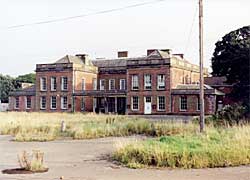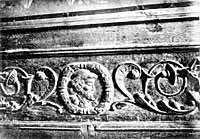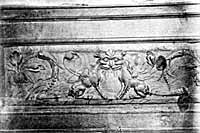
The north front of Colwick Hall prior to restoration (A. Nicholson ©2002). John Carr of York remodelled the existing 17th century house in 1776.
The internal details include some beautiful Spanish mahogany doors, with enriched mouldings and architraves, an elegant staircase having an elaborate mahogany balustrade ; enriched plaster ceilings and cornices ; multi-coloured marble chimney-pieces, &c., all carried out in the characteristic manner of the period, which has come to be known as the “Adams’ style.”
All traces of the moat were obliterated when the new hall was built. Between the south front and the river, there is a backwater with reed-bed, which might be mistaken for the moat. This is the ancient course of an artificial stream, diverted from the waters of Trent, in order to turn the wheel of the Saxon mill, mentioned in Domesday book. The exact site is lost, but the mill stood near the place where a little rivulet, probably the ancient “milnefleet,” enters the Trent, at the lowest level of the lordship of Overcolwick; for until the time of the Byrons, Nethercolwick was a separate holding.
In the days when rivers were the great highways of commerce, any interference with a watercourse was a matter for serious consideration; and seeing that the owners of Colwick continued to divert more and more water into this “trench,” until it was well-nigh impossible to navigate the river in time of drought, litigation ensued, which lasted for more than sixty years. This interesting case, of which the following is a brief summary, is fully set forth in the Borough Records, Vol. 1. June 29, 1330. An Agreement was entered into whereby, “whenever the water in the river was too low to admit the passage of ships and boats, they should be permitted to land on one side or the other of a creek at “Milneholm; from thence there was to be a convenient road for the use of the Burgesses of Nottingham” only, as far as the garden of the said Sir William (de Colwick) below his manor towards the east, and thence between two ditches as far as to the road which leads out of the Vill of Colwick to the Town of Nottingham. And if the depth of the water change so that the creek was no longer available, then “in front of a place called the arrival of Ralph Bugge, on the eastern side of a ditch which is called ‘Old Milneflete.’” If no charge was made for landing, then the Mayor and Commonalty granted to said owners of the estate “for making good accord and cherishing love for ever,” the right to charge a halfpenny for every cart, and a halfpenny for every horse-load (i.e., pack horse) which passed over his land: and the said Sir William “then of good and sound memory” set his seal to the bond.
But alas ! the trouble was not yet ended, for on November 16th, 1383, complaint was made that all the water of Trent ran into the trench to supply the mill, and that ships could not get up to the castle and town of Nottingham: King Richard II. therefore appointed eight local gentlemen whom he named, “or 7 .6 . 5 . 4 . 3 or 2 of them” as the phraseology went, to enquire into the truth of the complaint.
Eleven years later, June 16th, 1392, an Inquisition was held when Joan de Colwick and her husband Richard Byron attended in person to plead for themselves. It was then conclusively shown that the owners had “blocked up the right course of the waters of Trent for two leucae (i.e., nearly three miles) next the town of Nottingham, planting in the water aforesaid willows and osiers growing and taking root, and also placing in the water aforesaid piles of timber, a kidell (i.e., a weir with an outlet for catching fish) and great stones.” The sheriff was commanded “to throw down and remove the wear aforesaid, and all other nuisances therein without delay, so that ships and boats with victuals and other merchandise may go and return from the aforesaid water of H umber to the said Town and Castle, by the course of the water of Trent &c.”—“and the aforesaid Richard is in misericordia” &c.
Deprived of its motive power the mill became derelict, while the trench developed into a reed-bound lake, the haunt of the coot and heron, the kingfisher and the sedge-warblers.
In the stormy days which followed the Restoration of the Monarchy and Episcopacy, Colwick hall opened hospitable doors to the ejected ministers who resigned their benefices under the Act of Uniformity. Those twin souls, John Whitlock and William Reynolds,—of whom it was said “they lived together, they preached together, they travelled together, nothing but death could separate them;”—were presented together to the endowments of St. Mary’s, by the Marquis of Dorchester, at the request of the parishioners in 1657; the one as vicar, the other as lecturer. To quote Whitlock’s own words; “In October 1662 brother Reynolds & I, with our families, removed from Nottingham to Colwick Hall, about a mile from Nottingham, a house of Sir John Muster’s, where we lived till the Five-mile Act took place, which was the 25th March 1666. Some disturbance we met with while we lived there, though we received great respect and kindness from Sir John Musters, who would take no rent from us.”
During the Chartist riots of 1831, considerable damage was done to the hall and gardens. After the rejection of the Reform Bill, an unruly mob assembled in the Nottingham Market Place, on Monday, the 10th October. The 15th Hussars were called from the Park Barracks to disperse them.1 “One section however eluded their vigilance. Making their way Sneinton-wards they proceeded to Colwick. . . . Entering the mansion they began to lay about them with the railings they had torn from Notinton Place Sneinton; they ripped up the pictures, smashed everything they could, and finally set fire to a portion of the building.” Mr. Musters was away from home: Mrs. Musters had been confined to her bed, but at the time of the attack, was sitting in the drawing-room with her daughter, and Mademoiselle de Fey, a foreign lady, who was on a visit. They happily escaped to an adjoining shrubbery and notwithstanding the rain poured down, they lay concealed under the foliage of some thick spreading laurel trees till the rioters took their departure. “Here in evening dress Mrs. Musters received that shock to her system which terminated her life four months later (February 6th, 1832) at Wiverton Hall, the dower house of the Chaworths.”
The damage done to the structure, consisted chiefly in broken window-panes, but the valuable furniture, pictures, ornaments, and wearing apparel, were hopelessly ruined. A full-length portrait of Mrs. Musters, as Hebe, by Sir Joshua Reynolds; a Rubens, said to be then worth 1000 guineas; and five or six Italian pictures were all destroyed. Two windows on the staircase, painted by Mrs. Catherine Sophia Musters (1817), two years before she died, were smashed to fragments.
Three of the delinquents were sentenced to transportation for life, one of them having first received the death sentence, which was afterwards commuted.
“Sic transit gloria mundi.”
----------------------------
The Church stands but a short distance away from the hall to the westward. Although utterly debased as regards its architecture, it is not altogether devoid of interest. Domesday book tells of a church at Colwick even as early as 1086, but not a vestige of any work earlier than the Tudor period is now visible. This is the more to be regretted, seeing that the dedication is in honour of St. John the Baptist; for the mediaeval freemasons would surely have striven to make the building worthy of their patron saint. Even now, in its debased state, mason-marks are conspicuously displayed upon the 17th century tower; two triangles conjoined; three triangles around a triangle; and four squares around a square.
The oldest part of the present fabric is the spacious nave, which was built in the 16th century. There are no aisles, and the north and the south walls are alike, save that the doorway on the north side is now built up. The tall three-light transom windows, and the doorways, have straight-sided arches, with a small curve at the springing, such as are frequently met with in the domestic buildings of the Tudors. Sir John Byron of Colwick, acquired the site of the Priory of Newstead, at the Dissolution of Monasteries in 1540. Why he should have set out to rebuild Colwick Church during the troubled period which followed, is not clear, for church building was quiescent during the latter part of the reign of Henry VIII. This nave, therefore, exhibits a specimen of architecture which is exceptional, and I do not think the county contains another example of ecclesiastical work of that period. But what is more remarkable still, is the fact that a chantry altar was actually set up and consecrated within this church some years after chantries had been suppressed ; the particulars of this are set forth in the paper on the monuments.

 Colwick church—Dado panelling.
Colwick church—Dado panelling.In 1643, the Byrons removed to Newstead, and shortly afterwards the Colwick estates came into the possession of Sir John Musters, who “repaired the church at great expense, and new built the chancell and steeple.” In 1661, as a memorial of the Restoration of the Monarchy, the oak panelling was taken from the dining-room of the old hall, and made up into a dado and seating for the body of the church. The dado consists of two tiers of moulded raise-mitred panels, with a laid-panel above. There are thirty-two of these laid-panels in all, and each one is carved in low relief with Renaissance ornament, consisting of masks and scrollwork. Similar panelling, carved with the “linen-fold” pattern was used for the choir seats.
In 1684, the western tower and the chancel were rebuilt, and battlements were added to the nave, when the church assumed its present outward appearance, save that a vestry and organ chamber have been built on the north side in recent years. The tower, now used as a vestry, is bald and ugly, and the chancel would be uninteresting, were it not for the monuments which it contains. These can be seen but imperfectly in the dim light, which filters through the painted glass of the pseudo-gothic windows. Just about a 100 years ago, the east window was painted by that accomplished lady, Mrs. Sophia Musters, whose monument is on the south side of the altar. The figure subjects were copied from a window in the chapel of New College, Oxford, painted by Sir Joshua Reynolds, and they do the lady much credit.
There is a deep gallery across the west end of the church, and beneath it, a Carolean font.
(1) From Mrs. Gilbert’s Recollections of old Nottingham.
